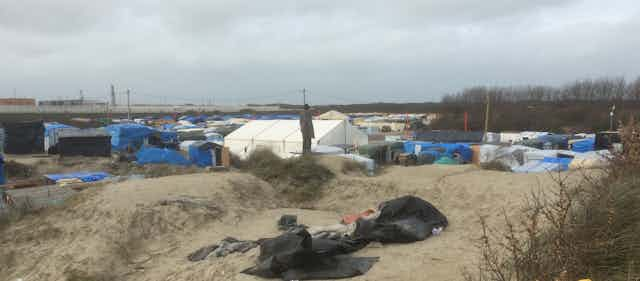French authorities have given up to 2,000 residents in Calais’ migrant camp one week to move, before a whole section of the camp – which includes a church, library, school, youth club, legal centre, theatre and many other makeshift social services – is torn down.
Threats of eviction have become more immediate in recent months, as security concerns around the camp have increased. But this kind of instability has long been part of everyday life in the settlement known as “the Jungle”. It is part slum, part camp; a bubbling cauldron of urban entrepreneurialism and humanitarian efforts, where volatility breeds experimentation. When I made the trip to Calais as a volunteer, I discovered that in many ways, the Jungle is not dissimilar to a modern-day city: it is fast-growing, entrepreneurial and closely monitored.
Urban opportunities
As conflict continues to drive people from their homes in the Middle East, and border controls tighten across Europe, Calais has become a bottleneck for people seeking to reach the UK. As a result, the population of the Jungle has grown from an estimated 800 people in 2009, to 6,000 in November 2015, echoing the global trend toward increasing urbanisation.
As a result of its growing profile, the Jungle has drawn a large number of volunteers offering aid. This has led to a huge increase in the diversity of services being provided – and the Jungle is now taking on distinctly “urban” characteristics. Perhaps most notably, it is becoming a space for entrepreneurial activity.
There are a growing number of restaurants, cafes, barbers, bathing rooms and other leisure services on offer. Because the Jungle is not formally recognised as a slum or a refugee camp, these activities have not received any “official” aid. Instead, people have begun to make a living via these entrepreneurial activities; this is a distinctly urban process.

Volunteer groups offering aid have proved to be similarly adaptable. One example can be found in the construction of prefabricated shelters for residents: tents are replaced with warmer, sturdier shelters, which are prepared off site and assembled in the camp. The design of these “prefabs” is tweaked along the way, with input from residents. The result is a dynamic process, involving both volunteers and refugees, which can adapt individual dwellings to particular needs.
When I visited, I also saw youth centres, theatres, educational services, playgrounds, immunisation programs, language lessons and even an embroidery class – all being offered by volunteers. The refugees are also bringing their own skills to the table, combining them with material provisions from the volunteers and donations to create their own services and activities.
For example, the “Good Chance Theatre” in Calais provides theatrical, performance and artistic pursuits for the refugees. Over time though, the refugees themselves have been able to begin running workshops and events based on their own cultures, entirely independently from those who established the theatre. All these activities are creating a tangible sense of community.
The uniquely experimental, urban conditions of the Jungle have allowed grass-roots, community-led humanitarianism to flourish. But they have also allowed for the camp to become a testing ground for methods of control and enforcement.
A climate of fear
This is most evident in the container housing, which has been provided by the authorities. Although they offer warm, clean and semi-permanent shelter for refugees, it’s not clear how inhabitants are selected and it is rumoured that tenure is limited to a few weeks. The containers are surrounded by wire fences and patrolled by security guards with attack dogs. They contain no community spaces and crucially, a condition of entry is the surrender of biometric data, in the form of a palm print. The camp inhabitants are highly suspicious of these new quarters: they are seen as a stealthy databasing technique, which could potentially hamper the chance to seek asylum in the UK.
What’s more, the police that surround the camp are implementing an experimental type of enforcement. Their use of violence and alleged illegal weapons seems random and indiscriminate. Their constant presence on the perimeter of the camp – in particular, the long line of vans perched on the shoulder of the motorway, overlooking the camp – are a constant reminder of the threat of violence and eviction. And sadly, the ubiquity of these forces has offered no protection against the violence directed by far-right groups toward refugees in the camp.

The sense of vulnerability instilled by such methods is reinforced when residents are evicted to make way for buffer zones. Earlier this year, after sustained attempts by refugees to gain access to vehicles on the motorway, police decided to impose a 100m buffer zone between the motorway’s edge and the camp. People were given roughly four days notice to move any shelters or structures that were occupying the area.
Many volunteer and refugee groups ceased their daily activities and scrambled to move shelters and prefabs to alternative sites. Lorries, low-loading vans, carts, forklift trucks and teams of people were all used to transport assembled prefabs across the camp. Despite these efforts, a church and a mosque in the buffer zone – which police agreed to leave untouched – were bulldozed without warning.
And so, the intense precariousness and instability that pervades the Jungle can be both an opportunity, and a curse. This place shows that people can come together to provide support and services for some of the world’s most vulnerable people. But there is also evidence of authoritarian brutality. The Jungle is a unique urban space, caught between the harsh realities of a geopolitical crisis and the rousing collective will of a humanitarian response. Which one wins out, only time will tell.

